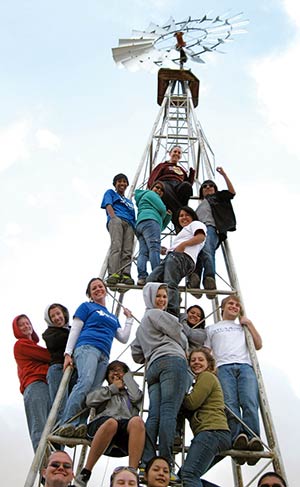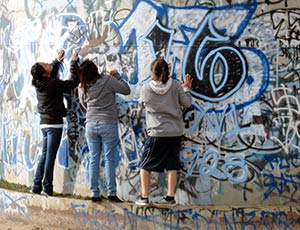Indianans and Indians
Cultural exchange brings ISU students to Piñon
By Cindy Yurth
Tséyi Bureau
PIÑON, Ariz., Oct. 13, 2011


(Times photos - Cindy Yurth)
TOP: Piñon High School students decipher gang graffiti on a water tank before painting over it last Friday. The service project was part of a three-year-old cultural exchange program between Pi–on High School and Indiana State University.
BOTTOM: Indiana State University students and Kristin Monts' English class at Piñon High School climb a windmill Friday before painting a graffiti-ridden water tank together. The students are part of a cultural exchange between ISU and the school.
The Piñon High School students pick out the insignia of at least three local gangs.
"The gangs are scary, sometimes," offers one student. "But they're just wanna-bes."
This is a gang of wanna-bes too. Wanna-be doctors, teachers and artists, to name a few. At the moment, they're wanna-be college students. Which is one reason they're out here in a sea of mud on their fall break, brandishing paint rollers against threatening skies, accompanied by 10 curious, fresh-faced white Midwesterners.
Their goals for today: 1) Paint over the graffiti. 2) Share their culture with the bilagaánas, all honors students from Indiana State University.
The Piñon teens are participants in the Indiana State University Cross-Cultural Excursion, a three-year-old program started by their English teacher, ISU alumna Kristin Monts, and ISU Honors Program Director Greg Bierly.
"We want to bridge cultural gaps and expand student knowledge on both ends of the spectrum," Monts explained.
Bierly said he hoped the trip also had the effect of making the rural Piñon students - who have now twice visited ISU - more familiar with a college campus, so they would be more comfortable about applying to college.
That part seems to have worked: 14-year-old Piñon freshman Dante Corum has already decided he's applying to ISU.
Corum, who visited the university with 11 classmates this spring, said he was charmed by the green landscape and the open Midwestern personality.
"Everyone was just so nice," he said.
The Anglo kids had a similar appraisal of Navajo culture.
"Everyone's been so friendly," said sophomore biology major Wesley Burcham. "We got a really nice welcome."
In addition to the service project at the water tank, the Indiana students spent their four-day visit last week shadowing the high school students, learning Navajo, and hosting a panel that gave juniors and seniors an opportunity to ask questions about college.
They did a few things just for fun, like shopping at the Chinle Flea Market and hiking Monument Valley with their Piñon counterparts.
"They received a true rez experience," noted Monts. "They slept on teachers' floors, survived muddy roads and blistering cold winds, and ate only traditional Navajo dishes."
The visitors noted some similarities between their lives and the rural Navajos', and a lot of differences.
Like Piñon, noted Burcham, Terre Haute is "a small town where there isn't that much to do unless you make your own activities."
Yes, but, um, certainly a college town of 61,000 has a few more options than Piñon, Ariz., population 1,249?
"Yeah, but here you don't have to wait for things to happen," Burcham said. "You can walk out your door and go for a hike."
The Indiana contingent immediately noticed a difference in the lives of the Piñon teenagers versus their off-rez childhoods.
"The kids have a lot of responsibility in their families," observed Rachel Hand, a junior in speech and language pathology. "They're wise beyond their years."
Probably, but on Friday they were just being typical adolescents, racing to climb the windmill by the water tank. The college students, just a few years older, hesitated a moment and then followed.
When you have youth in common, the cultural differences fade away.

